 by Jennifer Jones
by Jennifer Jones
Stone walkways are the perfect way to enhance your outdoor living areas and add beauty to your surroundings. Pathways are not only a gorgeous addition, but also functional, leading the viewer to a specific area. One of the most important aspects of your property is the walkway that leads to the front door of your home. A garden path is excellent for guiding admirers around your yard. There are many styles of paths, but the most popular is a stone walkway. They can blend in with most yards and are incredibly durable. A stone walkway is a relatively simple, inexpensive update and can be completed in a weekend.
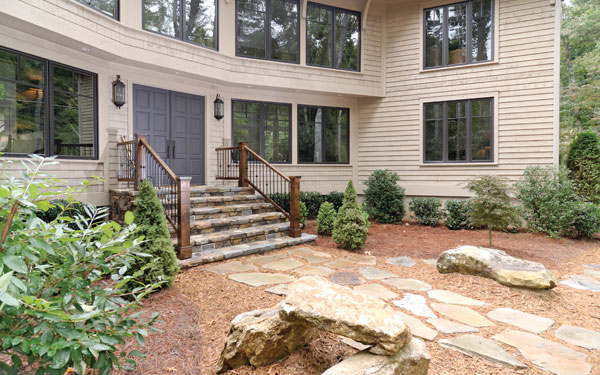
View This House Plan
View Other Luxury House Plans
A natural first step is deciding the length, width and position of the path. A rule of thumb is to make it wide enough so that two people could walk it side by side. Try to avoid building the walkway under large trees. Tree roots may eventually damage the walkway or the path may harm the roots. A more welcoming, relaxed walkway is often a curved path with unique features. Formal walkways are usually as straight as possible with plain materials that convey organization. A widely spaced, random stone path is better suited for gardens or secondary paths across lawns and backyards. A high-traffic walkway leading to a home's entry is best constructed with a smooth, uniformly cut stone set with tight joints to prevent trips and make walking easier. Calculate the square footage of the walkway area by multiplying the approximate width by the walkway's length. This square footage will give you an idea of the quantity of materials that you will need.
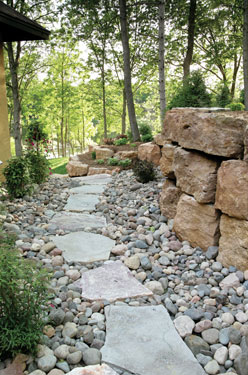
View This House Plan to the Left
View Other Rustic House Plans
Much of the fun of this project is the collection of rocks. The richness of texture, color, and finish in stones cannot be found in other materials. There are many different types of rocks and stones that can be used in your pathway. The area itself should guide you in selecting materials for your path. Many homeowners will use stones that suit their home’s architectural style. The clean, sharp lines of geometric-shaped stones make it a good choice for Modern home plans. Brick pavers and stone blocks are more consistent for Traditional home plans. Irregular stones give a rustic touch that adds to the character of country homes. Ideally, the material for stone walkways will consist of the flattest, largest solid rocks you can find and maneuver safely.
Stepping stones are used to give a natural, yet personalized style to your walkway. They are great for low-traffic areas that should blend in with the lawn and garden plantings. Stepping stones often have wide grass joints between each stones and are set deep enough in order to mow between them. For an enchanting art installation, consider creating your own stepping stones. Recycle plastic lids from anything that is deep enough to accommodate the cement, like deli trays. Pieces of ceramic tile, small stones, marbles, shells and glass are perfect to decorate your stone. Be sure to spray your mold with non-stick cooking spray for easy removal once the concrete has set. Pour the concrete in the mold and distribute your décor items to create stunning and stylish stepping stones.
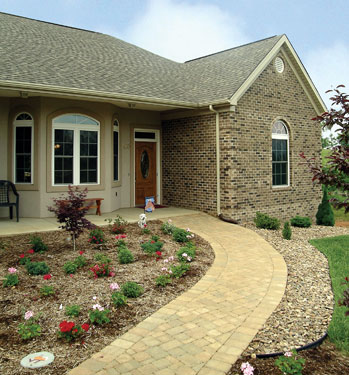
View This House Plan to the Right
View Other Ranch House Plans
Paving stones are a sophisticated, lasting element in landscaping. They allow for creating a network of patterns and colors, making every outdoor surface at your home unique. Pavers are made from a variety of materials and come in a wider variety of shapes, styles and colors. Three basic types of paving materials are natural stone, brick and concrete. Brick and natural stone are most commonly used in paths and edgings. Precast concrete pavers come in a uniform size and range in colors that resist fading, making them excellent for patios. Manufactured pavers interlock for easy installation, create neat borders and lows walls for a raised garden bed. Relatively inexpensive and easy to install, paving stones require little maintenance and are perfect for walkways, edgings, patios and decks.
After deciding and purchasing the walkway components, it is time to begin construction. If you are designing a straight path, use a string line to mark the edge of the walkway. For curved stone walkways, garden hoses provide the perfect curve line for your path. The width of the stone walkway should be fairly consistent from one end to the other. After tweaking the hoses or strings until the width looks correct, spray paint the lines to more permanently mark the borders of the walkway.
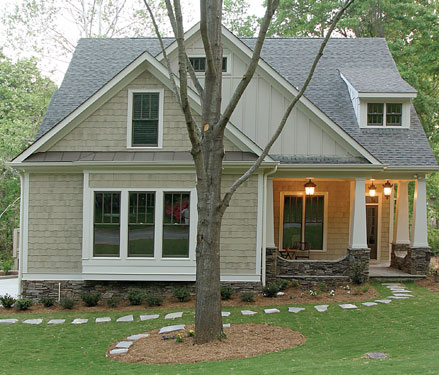
View Craftsman House Plans
The depth that needs to be dug out will depend on the width of your stones. Begin to dig on the edges and work inward. Once the desired amount has been excavated, moisten the soil and tamp it down for evenness. Lay down some weed block fabric to ensure those unwanted plants do no invade your walkway. A layer of sand on top of the weed barrier will be useful when permanently leveling the stones.
Begin laying and positioning the rocks. The type of walkway will determine which rocks to start arranging first. For a curved walkway, use your largest pieces and focus on the middle of the path. Since a straight walkway will require straight edges, select pieces of rock that will fit the line of the path border. Corners and other defined angles are the hardest ones to fit, so pick stones for those areas first and set them in place. As you search through your pile, set aside small stones that will be used to fill in gaps between the larger stones. Try to keep the gaps between abutting rocks as small as possible.
Once the stones have been relatively placed, it is time to permanently set the stones in their place. Be sure to stroll down your stone walkway using your normal gait. This experiment will help ensure the spacing of your stones feel correct to walk on. Using your carpenter’s level, check for levelness on each stone and nestle them into the foundation bed. It helps to stand or kneel on the stones as you work the crevices, rocking your weight a little to test for any loose spots where the stones may not be well supported by the bed. As you lay the stones, apply sand, rock dust or small pebbles to the remaining gaps and tamp it in as best you can. Leave your walk for a few days so that the stones can settle properly.
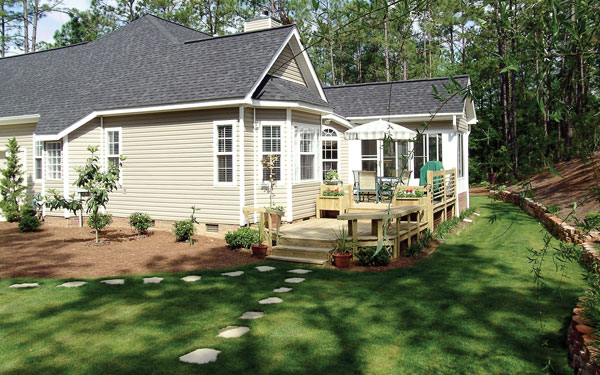
View This House Plan
View Other Ranch House Plans
For a simpler stepping stone path, position each stone at a comfortable walking distance. It is most beneficial to dig out the size of each separate stone. This will ensure that there will be grass around each rock. Sand can be used under each stone to help keep it level.
By keeping the surface of the stone walkway on the same level as that of the surrounding lawn, you will be able to mow right along the path.
Decorating your walkway is the most enjoyable step of this project. For curved walkways, consider planting bushel baskets of various sized, seasonal flowers. Arranging them along the walkway or clustering them at the bends or corners will provide beauty and color throughout the year. A birdbath, stone garden bench, or fountain can be a wonderful addition to highlight your garden space around the walkway. Solar ground lighting has become a very popular and inexpensive way to light gardens and lawns in recent years.
Their purpose is simple... to direct your attention to a destination. Stone walkways will entice you to keep moving down the path, while giving you a clearly defined space to walk. They also add a touch of beauty to your lawn and garden. Installing an inexpensive walkway will highlight the care that you have taken to making your home more appealing. Versatile and durable, a stone walkway is a wonderful way to enhance the “country” aesthetic of a yard and will last a lifetime.
Here are some related articles:
Save this article to:
back to top